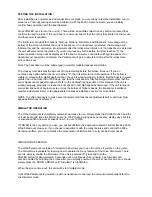
The right side of the Diagnostic screen evaluates external connections to the unit. The first category is
Transducer input. If a Tri-beam transducer is detected, the message will indicate "Tri-beam". (If a
transducer other than Tri-beam is detected, the message will indicate "Connected"). This is an excellent
way to confirm transducer connection. If a transducer is connected directly to the unit, the connection will
be indicated here. If a switch is used, use Diagnostic to confirm the connections from each transducer. If
a series of dashed lines is shown, then no transducer is connected or there is a problem with the
transducer or cable.
The next categories indicate the connection of boat speed sensor and surface water temperature sensor.
These accessory sensors can be purchased independently or together as a single sensor (see Available
Accessories). If the sensors are connected and working properly, a "connected" message will appear.
Note: The speed sensor can only be detected when the boat is in motion as the paddle wheel on the
speed sensor must rotate to produce speed input.
The voltage input category is especially helpful in diagnosing input voltage problems. The current input
voltage will be displayed. If voltage fluctuates or power supply in excess of 16 VDC or less than 10 VDC
is suspected, use the diagnostic screen to confirm input voltage. Often, small outboard motors do not
effectively regulate voltage when operated at high engine speeds. Use Diagnostic while running the boat
at high speeds to show the voltage gain. Also, if you are using the Wide Paramount in portable
configuration or from the trolling motor battery, Diagnostic can be used to evaluate the health of the
battery by showing the current voltage.
The total time category indicates the total time the unit has been in use since shipped from the factory.
Note: It is normal for some hours to be indicated in the total time when the unit is new due to factory
testing.
While this is often of interest to the user, it is primarily a diagnostic tool for the repair technician should
service be required.
Press VIEW to access additional Diagnostic information.
The second Diagnostic screen provides valuable information about the sonar function of the Wide
Paramount. The three columns of information show the raw sonar signal as it is seen by the unit.
This information is useful in both
troubleshooting a potential fault, as well
as aiding in the transducer installation
(for through the hull installations only).
The sonar diagrams indicate the
returned signal of each sonar pulse
transmission. By analyzing these
diagrams, the user can gain additional
insight into the performance of the unit.
The diagrams show time delay
(distance) on the vertical axis, and
amplitude or strength of return on the horizontal axis. An "amplitude" number shows the relative strength
of each return signal. The depth number shows the depth of water beneath the boat as measured by
each of the three beams.
With the boat stationary over a flat, consistent bottom, the sonar returns from the left and right beams
should be identical. Any discrepancy between these signals may indicate a problem with the location of
the transducer. (Often voids or irregularities in the laminated hull of a fiberglass boat will block or degrade
one or more of the sonar signals.)
By referring to this screen prior to permanently mounting a through-the-hull transducer, the location can
be adjusted until no visible loss is observed.
Summary of Contents for Wide Paramount
Page 1: ......

















